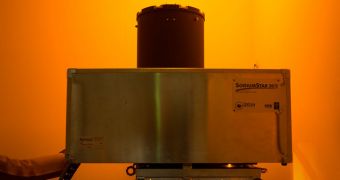The Very Large Telescope (VLT) on Cerro Paranal, in the Atacama Desert of Chile, is arguably already the best optical observatory in the world, but its performances are about to get a significant boost. Recently, officials with the European Southern Observatory (ESO) have announced that the 22-watt laser that makes up the centerpieces of the new VLT adaptive optics system has just been completed.
System supplier TOPTICA and partner MPB have just completed work on the 22-watt laser instrument, which will join four smaller lasers on the VLT. When the five instruments are fired together, they create one of the most advanced tracking and referencing light beams on any telescope in the world.
An adaptive optics (AO) system works by firing a laser beam through the Earth's atmosphere, and then analyzing how water vapors and other elements influence the photon stream. This helps astronomers figure out how twinkles in the atmosphere are changing light coming in from distant objects in space.
These data are then fed to a system of actuators installed underneath telescope mirrors, which reposition the latter so that they compensate for these atmospheric distortions. In effect, AO systems enable telescopes to look through Earth's atmosphere as if it were not even there.
ESO first issued an order for an AO tracking laser some 5 years ago, and has been working with MPB and TOPTICA ever since. The acceptance of the newly completed instrument marks a crucial milestone in the process to outfit the VLT with modern adaptive optics capabilities. The system will be outfitted to the Adaptive Optics Facility at Cerro Paranal.
ESO engineers have spent the past three months studying the laser and assessing its performances, and they say that all specifications are within the requested parameters. The instrument is capable of generating an artificial guide star at an altitude of around 90 kilometers (56 miles) above the surface.
A special technique employed in constructing the laser instrument allows it to generate light beams that are much brighter than other tools in its class. The AOF will be the first installation in the world to regularly use such capabilities when observing the night sky.
“The performance of these new lasers, once they are in operation on the telescope, will be of interest for future projects such as the European Extremely Large Telescope, which also has requirements for multiple laser guide star units,” ESO experts say in a statement accompanying their acceptance of the new instrument.
“The new laser delivers 22 watts, which sounds modest compared to standard lightbulbs, but when emitted in a coherent way the beam is very intense (and powerful enough to require special safety measures during operation). The challenge of such lasers is to efficiently produce light at the particular wavelength needed to create the artificial star,” the team explains.

 14 DAY TRIAL //
14 DAY TRIAL //